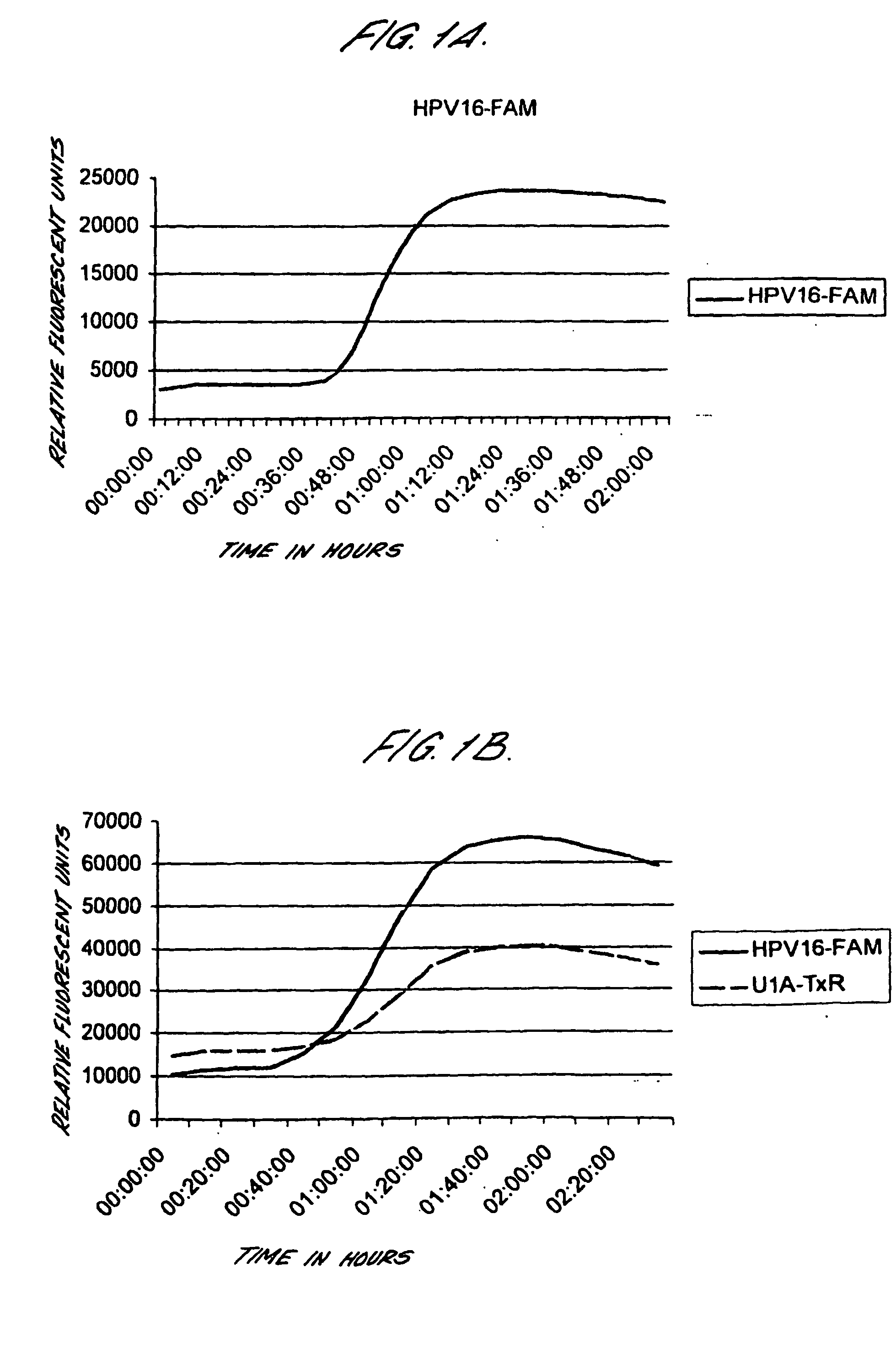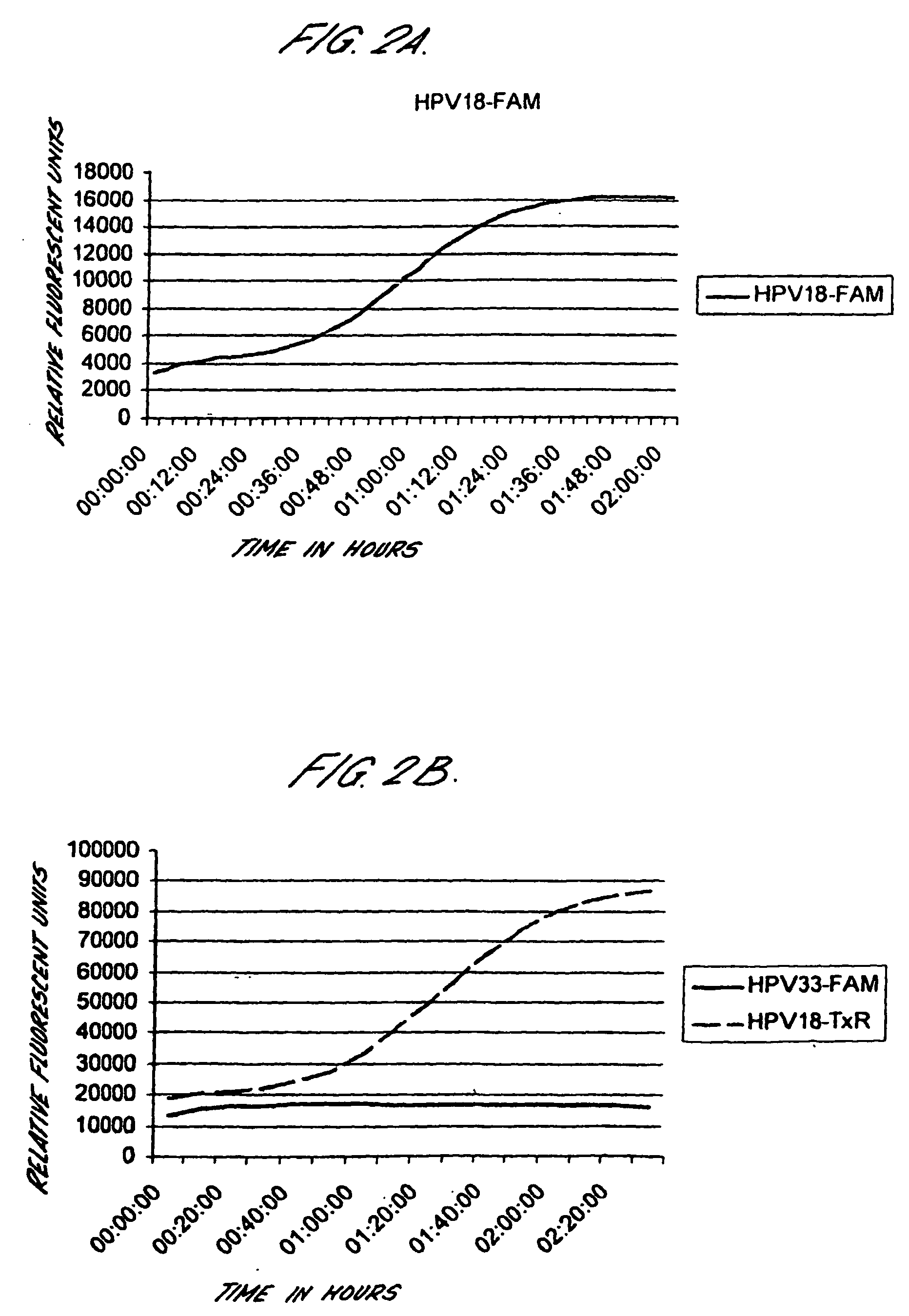Method for detecting human papillomavirus mrna
a human papillomavirus and detection method technology, applied in microbiological testing/measurement, biochemistry apparatus and processes, enzymes, etc., can solve the problems of low risk of these women, cell may soon develop some changes, and the possibility of regression of cell changes
- Summary
- Abstract
- Description
- Claims
- Application Information
AI Technical Summary
Benefits of technology
Problems solved by technology
Method used
Image
Examples
example 2
Sensitivity of Real-Time NASBA on Control Cell Lines
[0191] Cervical cancer cell lines, CaSki, SiHa and HeLa were diluted in lysis buffer either before automated extraction of nucleic acids using the Boom's extraction method from Organon Teknika / bioMerieux (parallels 1 and 3), or after nucleic acid extraction (parallel 2). Real-time NASBA was performed using molecular beacons probes labelled with Texas red (16, L1 and 18) or FAM (U1A, 33 and 31) following the protocol described above.
TABLE 9PrimerCaSkiCaSkiHeLasets and161616333333183118311831probesE6U1E6U1E6U1L1E6L1E6L1E6E6E6E6E6E6E6Parallels112233112233112233Number ofCells100 000+++++++−+−+−+−+−+− 10 000+++++++−+−+−+−+−+− 1 000+++++++−+−+−+−+−+− 100+++++++−+−+−+−+−+− 10++++++−−−−+−+−+−+− 1−−+−+−−−−−−−+−+−+− 10−1−−−−−−−−−−−−−−−−−−
[0192] Thus, it is possible to detect HPV E6 mRNA in less than 1 cell using real-time NASBA.
[0193] Real-time NASBA was tested both as a multiplex assay and as single reactions. The results from ...
example 3
Further Clinical Study in 190 Patients
Patients / Clinical Samples
[0223] Biopsies from 190 women admitted to Østfold central-hospital for treatment of CIN in the period 1999-2001. The mean age of the 190 women included in the study was 37.4 years (range 22-74 years). Biopsies were frozen in −80° C. immediately after collection.
Cytological Examination of Samples
[0224] The routine cytological reports were used to record cytological findings. No attempt was made to re-evaluate the slides. Each one of them indicated a CIN II-III condition, i.e. a high grade dysplasia or HSIL, which was the basis for hospital admittance, colposcopy and biopsy.
Histological Examination of Samples
[0225] A biopsy, here termed biopsy 1, was taken after a high-grade cytology report. If it confirmed a high-grade lesion (CIN II or III), the patient was again admitted to hospital, this time for colposcopically guided conization. Before the conization, but after local anesthesia was applied, a second biopsy ...
example 4
HPV Detected by PreTect HPV-Proofer and PCR Compared to Cytology and Histology:
[0235] Normal and ASCUS samples (including borderline smears) were determined by cytology. All samples were tested with consensus PCR and PreTect HPV-Proofer but only the consensus positive samples were typed by PCR. The CIN 3 and cancer samples were determined by histology and all the samples were tested with all three methods. The results are shown in FIG. 6. Concordance between real-time multiplex NASBA and PCR compared to cytology or histology is shown in Table 15 below.
TABLE 15Concordance between real-time multiplex NASBAand PCR compared to cytology or histologyCytology / HistologyConcordancea (Number)Concordanceb (Number)Normal98.2% (4043)42.8% (138)ASCUSc94.5% (55)78.6% (14)CIN 394.3% (53)93.2% (44)Cancer99.0% (196)98.8% (170)
Only samples positive by Gp5+ / 6+ PCR have been typed.
aIncluding PCR and real-time multiplex NASBA positive and negative samples.
bIncluding only PCR and / or real-time multip...
PUM
| Property | Measurement | Unit |
|---|---|---|
| total volume | aaaaa | aaaaa |
| pH | aaaaa | aaaaa |
| temperature | aaaaa | aaaaa |
Abstract
Description
Claims
Application Information
 Login to View More
Login to View More - R&D
- Intellectual Property
- Life Sciences
- Materials
- Tech Scout
- Unparalleled Data Quality
- Higher Quality Content
- 60% Fewer Hallucinations
Browse by: Latest US Patents, China's latest patents, Technical Efficacy Thesaurus, Application Domain, Technology Topic, Popular Technical Reports.
© 2025 PatSnap. All rights reserved.Legal|Privacy policy|Modern Slavery Act Transparency Statement|Sitemap|About US| Contact US: help@patsnap.com



